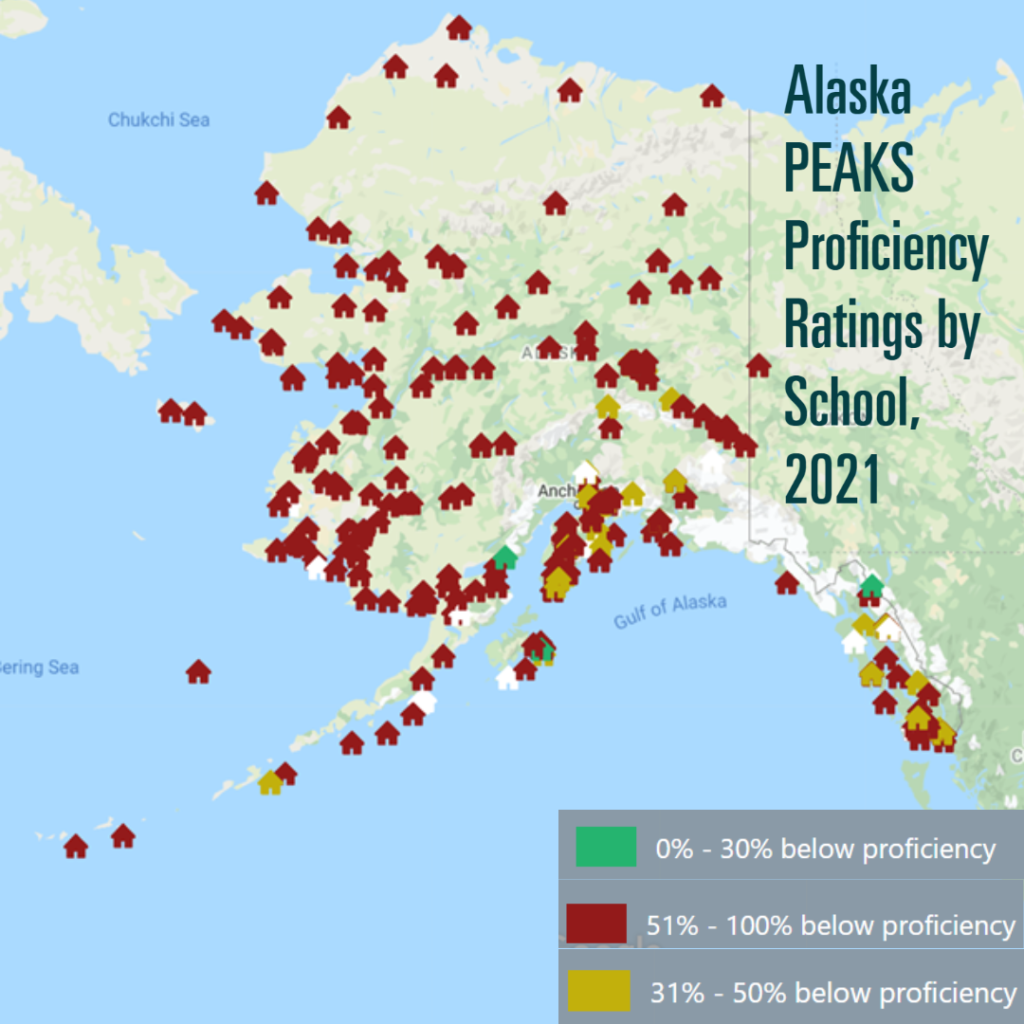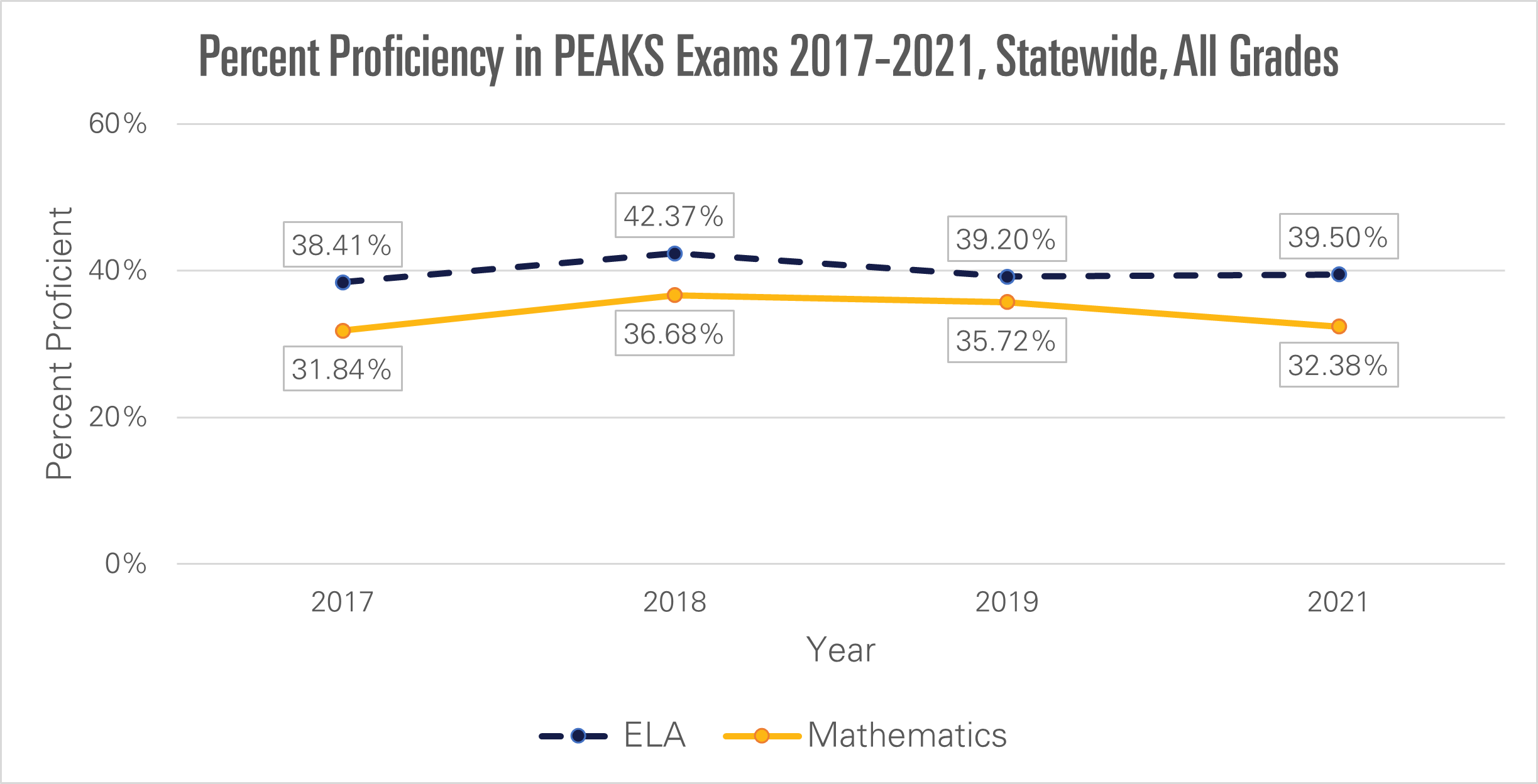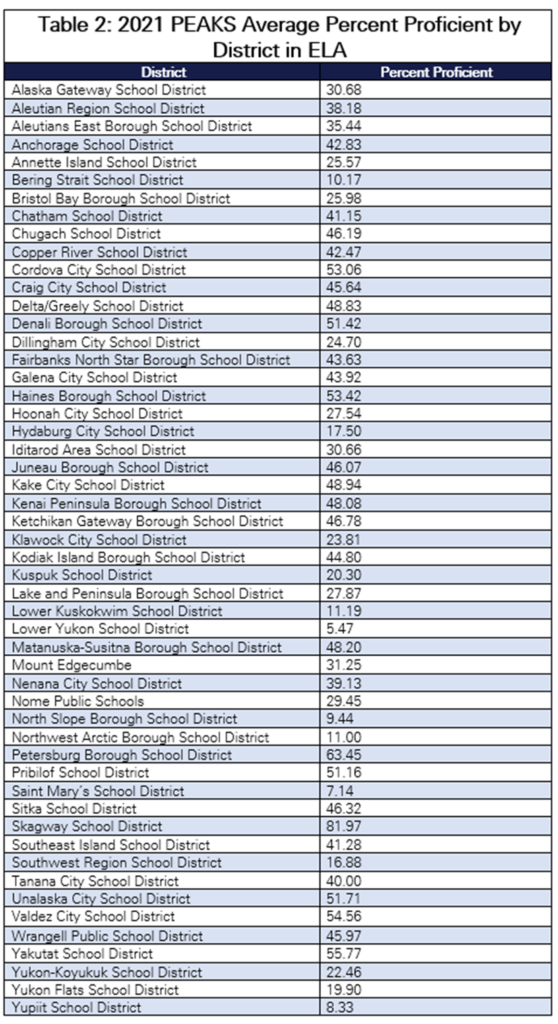 School closures and uncertainty in 2020 and 2021 certainly did no favors for Alaskan students. The 2021 Performance Evaluation for Alaska’s Schools (PEAKS) results are now available, and they reveal particularly worrisome trends in proficiency, especially in mathematics. More than two-thirds of Alaska’s public school students aren’t proficient in mathematics, and the pandemic has reversed most of Alaska’s math gains since 2017. Approximately the same percent of students are proficient in English Language Arts (ELA) in 2021 as in 2019, indicating that the unstable learning environment of the last two school years may have been less damaging for English reading and acquisition skills.
School closures and uncertainty in 2020 and 2021 certainly did no favors for Alaskan students. The 2021 Performance Evaluation for Alaska’s Schools (PEAKS) results are now available, and they reveal particularly worrisome trends in proficiency, especially in mathematics. More than two-thirds of Alaska’s public school students aren’t proficient in mathematics, and the pandemic has reversed most of Alaska’s math gains since 2017. Approximately the same percent of students are proficient in English Language Arts (ELA) in 2021 as in 2019, indicating that the unstable learning environment of the last two school years may have been less damaging for English reading and acquisition skills.
However, the results indicate that reading by age nine should remain a priority for policymakers to compensate for pandemic learning losses. Of grades 3 through 9, third graders were the least proficient group in ELA. These results also suggest that one-size-fits-all education isn’t working for more than two-thirds of Alaska’s students, as public charter schools again outperformed traditional public schools. Giving families more choice in how to educate their children would help Alaska’s students recover. In this report, we examine the results of the 2021 PEAKS exam in-depth.
Methodology Notes
The PEAKS assessment contains two sections, English Language Arts (ELA) and mathematics, which public school students third grade through ninth grade are required to take. The PEAKS exam was administered with success for the first time in 2017, overhauling previous standardized tests that the state believed no longer conformed to rigorous standards. Results are available from the 2017, 2018, 2019, and 2021 administrations of the exam.
Due to the pandemic leading to lasting closures of in-person learning in the spring of 2020, there was no 2020 administration of PEAKS. The 2021 PEAKS exam had much lower statewide participation rates than in previous years, of 65 percent in ELA and 64 percent in mathematics. For comparison, PEAKS 2019 had almost 91 percent participation in both tests. The Alaska Department of Education and Early Development (DEED) cautions against comparing PEAKS data to previous years given flexible testing protocols between districts, reduced reporting requirements, and variability in participation between student groups.
However, there are several useful reasons to conduct analysis on the 2021 results despite these caveats. In actuality, the 2021 results may be a lenient estimate of how students are faring across the state in reading and mathematics. Students that did not participate in the exam often did not participate because they are continuing to learn virtually, which works for some students, but not for all. It is unclear whether the group of students continuing to learn virtually would have performed better or worse on the PEAKS exam, but given the abrupt transition to online learning and the mixed success of online learning nationwide, it’s likely that many online-only students continue to struggle. The difficulties of 35 percent of Alaska’s students may not be accounted for in the 2021 PEAKS results. In addition, simply because the U.S. Department of Education waived accountability requirements for 2021-2022 doesn’t mean that parents, policymakers, and the public should not hold schools accountable for their performance during the pandemic.
The measure that the State of Alaska publicly reports for the PEAKS results is percent proficiency, which means the percentage of students in a school that is meeting or exceeding achievement level descriptors (ALDs) for each subject. To obtain this figure, the number of students testing proficient is divided by the number of students tested, giving a percent proficiency for the school. Broadly, the proficient category includes students scoring either in the proficient or advanced range, and the not proficient category includes students scoring below proficient and far below proficient.
Source: “PEAKS Data Map”, Alaska Policy Forum, 2021
Some schools are required to report their percent proficiency as a range due to privacy concerns. If the achievement level (“advanced/proficient” or “below/far below proficient”) contains between zero and two students, “the number of students will be eliminated [from the data] and the percentage of students at each achievement level will be reported as a range.” For schools with fewer than five students tested in total, no results will be reported.
In this analysis, schools that tested fewer than five total students were excluded from the results. For achievement levels reported as a range, such as “40% or fewer not proficient,” the most generous 40 percent proficiency is assumed. Because the data is provided as school-level percent of students proficient, not at the student level, these averages may differ from the district-level results found here, which are calculated by the individual results of each student in the district. Thus, the DEED results should be considered authoritative, but the results in this report can be considered as averages of school proficiency within a district.
Starting in the 2021-2022 school year, Alaska will be transitioning away from using the PEAKS assessment in favor of the Alaska innovative assessment system, which may offer more continuity in testing between K-2 and grades 3-9. Previous PEAKS results will not be comparable to the new assessment. More information on the new system is available here.
State-Level Findings of Alaska Public School Student Results
Statewide across all grades, 60.50 percent of students were below or far below proficient in ELA. Across all grades, 67.62 percent of students were below or far below proficient in mathematics. Compared to 2019, there was a 0.3 percent increase in proficiency in ELA and a 3.34 percent decrease in proficiency in mathematics. Figure 2, below, plots the percentage of students proficient in ELA and mathematics across the state in both subjects for 2017, 2018, 2019, and 2021, the years for which data is available.
As evident in Figure 2, percent proficiency in ELA for 2021 is approximately the same as the percent proficiency in ELA in 2019. However, in math, there were three percent fewer students testing proficient and students are only slightly more proficient than they were in 2017.
Figure 2
Source: 2021 PEAKS Assessment Results, Alaska Department of Education and Early Development.
Statewide, there is noticeable variation between percent proficiency in each grade. In ELA, the most proficient group were sixth-graders, of which nearly 47 percent were proficient. In comparison, the least proficient group in ELA were third graders, of which only 36 percent were proficient. This is particularly relevant because children who fail to learn to read by age nine continue to struggle with reading, understand less class material at higher grade levels, and are more likely to drop out of high school. The most proficient group in mathematics were third graders, of which 38 percent were proficient. The least proficient group in mathematics were eighth-graders, of which only 26 percent were proficient.
Figure 3 also reveals that in each grade, proficiency in mathematics lags proficiency in reading. This rule does not hold for third grade, where slightly more third-graders were proficient in mathematics than were proficient in reading. The grade with the widest gap between ELA and mathematics proficiency were seventh graders, as 42.54 percent of seventh-graders were proficient in ELA but only 27.75 percent were proficient in mathematics.
Figure 3
Source: 2021 PEAKS Assessment Results, Alaska Department of Education and Early Development.
District-Level Findings
Across all districts and across all grades, Skagway City School District had the most students proficient in ELA (81.97 percent) and the most proficient in math (77.42 percent). Participation rates were 92 percent for the ELA test and nearly 94 percent for the math test, out of a total enrollment of 65 students.
Across all districts and across all grades, Lower Yukon School District had the fewest students proficient in ELA (2.40 percent) and the least proficient in math (1.31 percent). Participation rates were 88 percent for the ELA test and 88 percent for the math test, out of a total enrollment of 1,134 students.
Of Alaska’s major school districts, Anchorage School District was nearly 43 percent proficient in ELA and nearly 37 percent proficient in math for all grades. Participation rates were 72 percent for the ELA test and 71 percent for the math test, out of a total enrollment of 22,112 students. Fairbanks North Star Borough School District was nearly 45 percent proficient in ELA and nearly 33 percent proficient in math for all grades. Participation rates were 74 percent for the ELA test and math test, out of a total enrollment of 6,098 students. Matanuska-Susitna Borough School District was nearly 50 percent proficient in ELA and 42 percent proficient in math for all grades. Participation rates were 69 percent for the ELA test and 67 percent for the math test, out of a total enrollment of 9,762 students.
Table 1 shows the average percent proficient in each district in math, calculated by averaging the reported percent proficient in math of each school within the district. For districts with only one school, this number corresponds with the official average percent proficient reported by DEED.
Table 2 shows the average percent proficient in a district in ELA, calculated by averaging the reported percent proficient of each school within the district. For districts with only one school, this number corresponds with the official average percent proficient reported by DEED.
A Closer Look: Differences Between Public Charter Schools and Traditional Public Schools in 2021
Available evidence suggests that public charter schools fared better in the pandemic than traditional public schools, though this is largely speculative.
Previous analysis of the differences between public charter schools and traditional public schools revealed that for each subject, and for every grade, charter schools outperformed traditional public schools in 2019. For ease of the current analysis, charter schools refer strictly to the charter schools listed in the Charter School Directory and do not include ABC Schools, correspondence schools, or homeschools, which means the 2019 analysis is not comparable. Also, this analysis averages the reported school proficiency in each grade and subject, not averaging the scores of each student in each school or each district, because that data is unavailable due to privacy concerns. This analysis should then be considered a check-up on charter school and traditional public schools after the pandemic rather than an authoritative statistic.
Figure 4 calculates the average percent proficiency for charter schools in both ELA and math by grade. Charter schools across all grades averaged 59.45 percent proficient in ELA, nearly 25 percentage points higher than in traditional public schools, as shown in Figure 5. Note that because relatively few charter schools serve high-school-age students, there is statistical bias present in the small sample sizes for grade nine that may be disproportionately decreasing or increasing the score. This may explain why the average percent proficient for mathematics exceeds the average for ELA in grade nine, the only charter school grade in which this occurs.
Figure 4
Figure 5
Figure 5 shows the average percent proficient by grade in both ELA and math for public schools with charter schools filtered out. For sixth-graders, which have the highest percent proficient in ELA for both charter and traditional public schools, there is still a difference of 21.59 percentage points between their scores. The only grade and subject in which traditional public schools exceed charter schools is grade nine in ELA, by 8.77 percentage points; however, this may simply reflect that few charter schools serve high-school students and charter school students often enter traditional public schools in high school, leaving a smaller sample size for charter schools.
Because of differences in methods between the 2019 analysis and the 2021 analysis, along with low participation rates in the 2021 exam, the 2019 and 2021 results are not comparable.
Conclusion
Key findings:
- More than two-thirds of Alaskan students are not proficient in mathematics, erasing most recorded gains since 2017. Online learning in 2020 and 2021 may be less damaging in ELA, but our students are still stagnating.
- Third graders were the least proficient grade in English Language Arts, which is a particular concern because children who fail to learn to read by age nine continue to struggle with reading, understand less class material at higher grade levels, and are more likely to drop out of high school.
- The achievement gap between Alaska’s charter schools and traditional public schools remains high.
Resuming standardized testing in 2021 was a crucial first step to quantifying the learning loss of students during the extended school closures and uncertainty of 2020-2021. The school system’s response to the pandemic has revealed that one-size-fits-all education – in this case, hastily-implemented online learning – just doesn’t work for many students. One low-hanging solution is for parents, teachers, and policymakers to focus on preventing further disruptions to students’ learning environment, whether that student is in a traditional public school, charter school, online learning, or homeschooling. However, more lasting reform will be needed to ensure all third graders are reading by age nine, which is not only important to the students, but to Alaska’s society and economy. Strong charter school performance, even in the pandemic, offers some hope to parents who can enroll, but funding students instead of institutions would help every child get the support they need to succeed.






